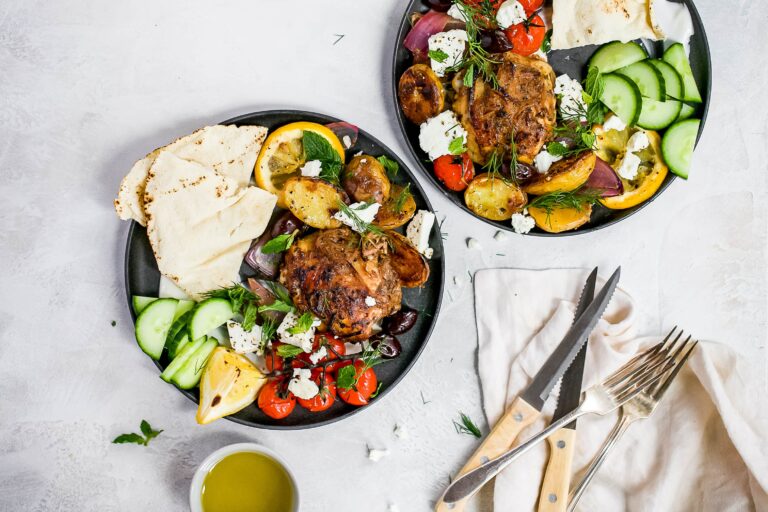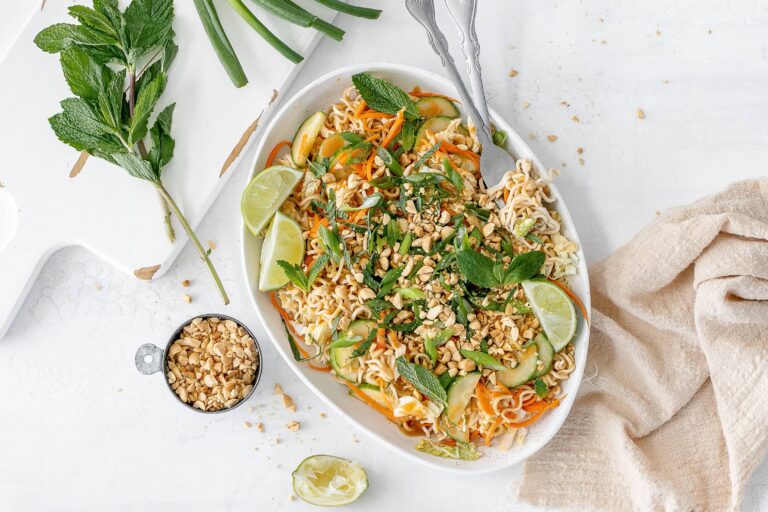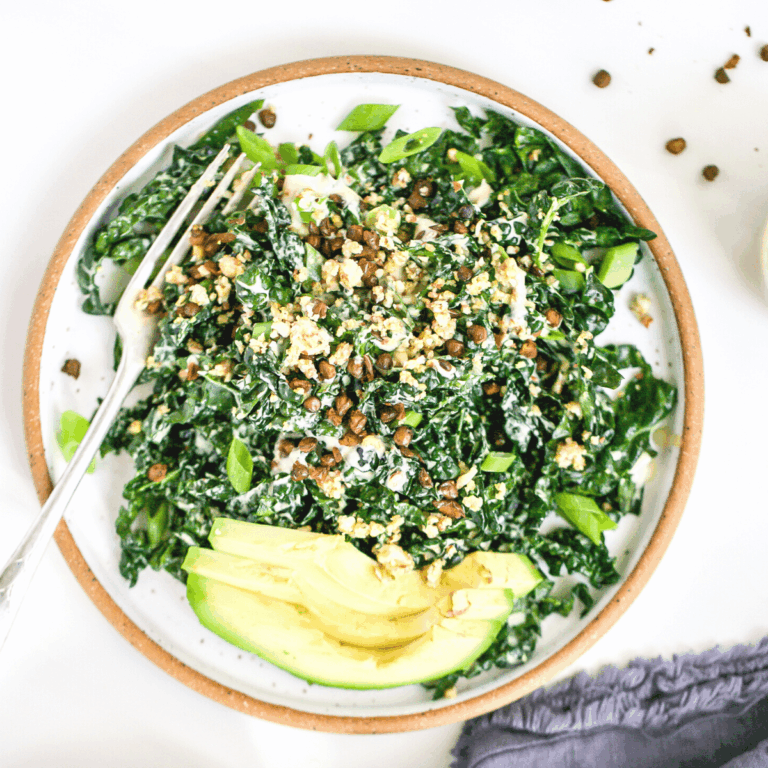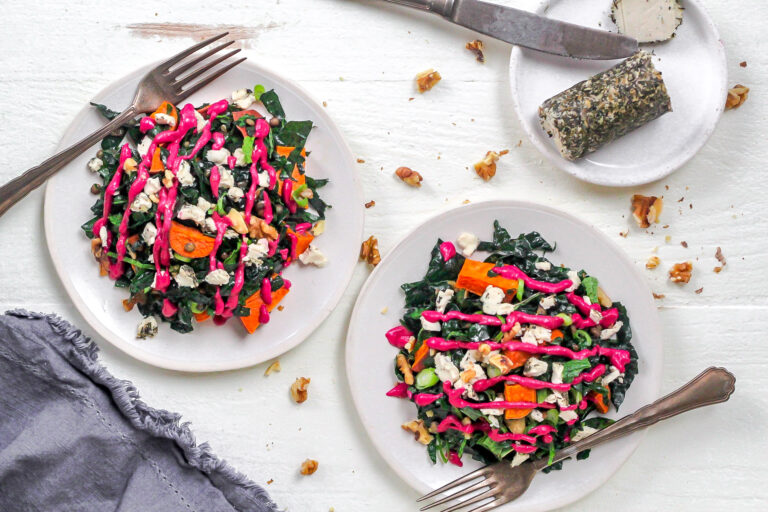Healthy Pad Thai: Delicious and Authentic
This post contains affiliate links, which means I may receive a small commission at no extra cost to you. I only share products and services I have personally used and love. Disclosure here.

I’ve been pretty obsessed with Thai food for a while now. Ever since I had my first bite of Pad Thai well over 10 years ago, I knew it was special. I’d get intense cravings for those delicious rice noodles packed with so much flavour that I’d end up going almost weekly. It wasn’t until I moved from the suburbs to downtown that I had to find a new Thai place to go to. Quickly, I found a new spot that served delicious and authentic Pad Thai and before I knew it, I was visiting frequently. And the obsession continued, until I made this healthy Pad Thai…
Trying to Make it My Own
When I moved out on my own, I got really into cooking. Soon, the best part of my day consisted of deciding what to make for dinner. At my 9-5, I’d spend all my free time (lunches and breaks) perusing food blogs and looking at recipes. So when I set out to try and make my own Pad Thai, I made the rather amateur mistake of thinking I could make it one evening during the work week. Making Pad Thai doesn’t necessarily take a long time, but getting all of the components ready can take some time. For example, I bought tamarind and had to make my own paste, which isn’t labour intensive, but it does take some soaking time. And then the actual time spent pushing it through a sieve, it all adds up. Needless to say, I didn’t sit down to eat until probably 8 pm. And on top of all that, it didn’t taste quite right.

Nailing the Pad Thai Sauce
Because the thing is, for Pad Thai to be good, the sauce needs to be great. So after that first attempt, I tried again several times over the years. Sometimes it was better than others, but overall it was lacking something. To be honest, making my own Pad Thai was the bane of my existence (yes, I’m dramatic) for a while. I couldn’t figure out why it was SO hard to get it right. So, when I finally figured it out, I couldn’t believe how simple it really was to make.

What Makes a Delicious and Healthy Pad Thai Sauce?
Curious as to what makes a good Pad Thai sauce? Here are all the tips I learned that are ESSENTIAL in making a delicious, healthy Pad Thai sauce:
Fish Sauce:
Yes, you can technically make Pad Thai without fish sauce and the sauce can still taste good, I haven’t figured it out yet though. When I was vegan, I frequented a spot here in Toronto that made a wicked vegan Pad Thai. The flavours are a bit different, but it’s still good. However, if you aren’t vegan, I highly suggest getting a good, high quality fish sauce.
Prior to me getting a good fish sauce, I kept getting a mediocre sauce. I didn’t understand how important the fish sauce was. Now, I use this fish sauce from Red Boat, which I purchased on Amazon and it makes a BIG difference! This brand only uses anchovies and sea salt, with no added sugar, unlike most brands. It’s the best tasting one I’ve tried, and 100% worth the higher price tag.
Sugar:
The thing I love about Thai food so much is the importance of balancing all the flavours. Sugar is needed in the sauce to help balance the sour and saltiness, so don’t skip it. I use a little less than what is in other typical Pad Thai recipes, but that’s simply because I don’t have a big sweet tooth. So feel free to add a little more sugar if you want or need. I like using coconut sugar.
Tamarind:
That beautiful colour on a good Pad Thai comes from tamarind. Although it isn’t just colour that tamarind provides. The flavour of tamarind is quite unique as it’s sour and sweet. That sour component is needed to balance the saltiness from the fish sauce. I wouldn’t make Pad Thai sauce without tamarind.
Where to find Tamarind?
You can purchase the paste already made (I have in the past), however, it usually has added ingredients and isn’t as good as making your own. For this reason, I highly suggest making your own paste. It’s actually kind of fun to make, as you push it through the sieve. And you can make this in advance and keep it refrigerated so you can whip up this healthy pad thai quickly. Don’t make the same mistake I did, make the paste ahead of time! See below for pics of what it looks like throughout the whole process.
How to Make Your Own Tamarind Paste At Home For Pad Thai
First, add the tamarind block to a large bowl and pour some just boiled, hot water over top and let it soak for 30 minutes.
After 30 minutes, use your hands to break apart the tamarind as much as possible. Prepare a sieve over top of a large bowl and pour half the tamarind and water in the sieve and push it through to make the paste. Use your hands to really push it through the sieve to ensure you get as much as possible from the tamarind. Repeat with the remaining piece of tamarind, until it’s done and you have gotten as much as you can from the tamarind. There will be pieces remaining. You will be able to get about 2 cups of tamarind paste.

Next, in a small saucepan over medium-low heat, add the tamarind paste and bring to a low simmer, stirring frequently. Once it has boiled and simmered for a few minutes, remove from the heat and pour into mason jars.

Tips to Make a Healthy Pad Thai?
Turns out, Pad Thai on its own isn’t unhealthy by any means. The thing is, whenever I get takeout, I am always blown away by the amount of noodles, and oil. It’s often just excessive. I like noodles as much as the next person, but I don’t need a mountain of it, without any other veggies. So I halved the amount you’d typically use and added sweet potato noodles instead.
- Add More Veggies: Swap out the noodles as I did for half rice noodles and half spiralized sweet potato. I don’t suggest zucchini as I find it gets too watery. And if you want, add some steamed or stir fried veggies such as broccoli (like I did), cauliflower, sliced carrots and bean sprouts.
- Add Some Protein: In order to help balance this meal out, I suggest adding some protein to it. For this one, I used sliced tofu and an egg. You could add in chicken, or shrimp to this as well.

How to Make Pad Thai Quickly?
Making healthy Pad Thai doesn’t take long, but the prep work can take a bit of time. Once you start cooking, it’s important to have everything ready to go. The tips below will help ensure the process is as smooth as possible!
- Cook the veggies first and set them aside.
- Spiralize the sweet potato and cook that with the veggies. You can add everything back to the pan once you’re ready to add the sauce.
- For this reason, have the tamarind paste ready and the sauce ingredients blended as well.
- If using tofu, ensure that it’s pressed and ready to be cooked.
- And soak the noodles!

Please Don’t use Ketchup or Almond Butter, Ok?!
Ketchup in Pad Thai is a HARD NO! First, I just don’t like ketchup much at all, but second, it has zero place in a Pad Thai sauce. Sorry, not sorry. If you can’t make the tamarind paste, buy one already made, but don’t sub ketchup in for it. They aren’t the same thing at all.
Almond butter is awesome and I love almond butter sauces as much as the next person. But, it doesn’t belong in a Pad Thai sauce! I am a bit obsessed with Pad Thai as you can probably tell, so I take the sauce quite serious. And I don’t think almond butter is authentic at all. If you want an almond butter sauce with noodles, I am all for it, but let’s just not call that Pad Thai, K?
Phew, it feels good to get those out in the open. Can you tell I am a Pad Thai snob?! I prefer enthusiast, but whatever.

How to Store this Healthy Pad Thai
I find eating the Pad Thai when it’s fresh and hot is the best way to consume it. But, you could also store leftovers afterwards as well. I recommend storing it in an airtight container in the fridge for up to three days. Then to reheat, simply stir fry it in a pan over medium heat for about 3 to 5 minutes. The noodles will cook a little more and may get a little softer, but overall I think it’s still pretty tasty. A little splash of avocado oil doesn’t hurt here one bit.
Are you ready to make this healthy Pad Thai? Let’s jump into the recipe then! It may seem like this recipe is quite long and intimidating, but I wanted to provide as much info as possible. And although it may take a little while to prep, once you have everything ready, it comes together very quickly.
And if you’re a Pad Thai enthusiast like me, please let me know if you try this healthy Pad Thai recipe by tagging me on Instagram or leave a comment/rating or review below.
This post contains affiliate links, which means I may receive a small commission at no extra cost to you. I only share products and services I have personally used and love. Disclosure here.
Print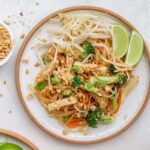
Healthy Pad Thai: Delicious and Authentic
- Prep Time: 20
- Cook Time: 15
- Total Time: 35 minutes
- Yield: 4 1x
- Category: dinner
- Method: stovetop
- Cuisine: Thai
- Diet: Gluten Free
Description
This delicious and healthy pad thai is made with an authentic tamarind sauce, and has tofu, bean sprouts and lots of veggies.
Ingredients
For the Sauce:
- 225 g Tamarind soaked, made into paste, see directions for how much to use for the sauce
- 2.5 cups Hot Water for soaking the tamarind
- 3 tbsp Fish Sauce
- 2 tbsp Coconut Sugar
- 1/2 Lime juiced
- 1–2 Thai Red Chili Pepper de-seeded, see notes
For the Pad Thai
- 4 oz Pad Thai Rice Noodles about 2-3 mm thick
- 1 head Broccoli chopped into florets, about 2 cups
- 1 tbsp Avocado Oil divided, as needed
- 1/2 Sweet Potato medium sized, spiralized
- 1 Shallot finely chopped
- 8 oz Tofu sliced into strips, drained (extra firm)
- 2 cloves Garlic minced
- 2 Eggs
- 1 cup Bean Sprouts
- 1/4 cup Roasted Peanuts chopped
Instructions
For the Tamarind Paste
- Add the tamarind block to a large bowl and pour the just boiled, hot water over top and let it soak for 30 minutes.
- After 30 minutes, use your hands to break apart the tamarind as much as possible. Prepare a sieve over top of a large bowl and pour half the tamarind and water in the sieve and push it through to make the paste. Use your hands to really push it through the sieve to ensure you get as much as possible from the tamarind. Repeat with the remaining piece of tamarind, until it’s done and you have gotten as much as you can from the tamarind. There will be pieces remaining. You will be able to get about 2 cups of tamarind paste.
- In a small saucepan over medium-low heat, add the tamarind paste and bring to a low simmer, stirring frequently. Once it has boiled and simmered for a few minutes, remove from the heat and pour into mason jars.
- Reserve 1/4 cup tamarind paste for the recipe and store the rest in the mason jar(s) in the fridge. You can store this in the fridge for a few months, possibly even longer.
For the Pad Thai Sauce
- Add the 1/4 cup tamarind paste along with the fish sauce, coconut sugar, lime and chili peppers to a blender and blend on high until smooth. Set aside.
For the Pad Thai
- Soak the noodles in a large bowl or dish in cold water, until softened. This takes about 10 to 15 minutes. Drain and rinse just before you’re ready to cook them.
- In a large non stick pan or wok, over medium heat, add the broccoli florets along with a splash of avocado oil. Cook for 2 to 3 minutes, until bright green. Add the spiralized sweet potato noodles and cook for an additional 2 to 3 minutes. Remove and set aside.
- In the same pan, add more avocado oil as needed, and over medium heat, add the shallot and cook for 2 to 3 minutes. Then add the tofu and cook for an additional 3 minutes, add the garlic and toss everything to coat for about 1 more minute.
- Add the rice noodles, half the sauce and toss to coat, then add the sweet potato noodles and broccoli back into the pan along with the remaining sauce and quickly toss. Move the noodles to the edge of the pan and add the eggs. Let them sit for about one minute and then scramble them. Move the noodles to be on top of the eggs, add the bean sprouts and cook for about one more minute. Turn the heat off and give everything one final toss.
- Divide onto plates and top with chopped peanuts, extra bean sprouts, lime wedges and green onion.
Notes
Thai Red Chili Pepper: These can be quite spicy if you leave the seeds in, I suggest de-seeding them as they are still spicy on their own. Start with one if you are unsure and then taste and adjust as needed. You could also try using red chili flakes, although it won’t be quite as spicy and flavourful.
Use tongs to toss the noodles once they are added to the pan, this is the easiest way to coat everything.
Green Onions: You can substitute Chinese chives if you want it more authentic. If you can’t find Chinese chives, you can use green onion or omit.

